It feels surreal to find myself at Lower Smite Farm as one of the latest recruits to the conservation trainee team. As a “veteran” volunteer with the Trust, I have previously spent many evenings and weekends contributing to the Redditch local group, Worcestershire Recorders, Trench Wood work parties and lots of other conservation activities. In 2019, I decided that I really should be involved in conservation as a full-time occupation and I decided to switch careers from engineering by enrolling on an MSc in Conservation Management at Edge Hill University. I got the degree but I struggled to find employment so, after a year or so with the Trust’s roving volunteers, farm volunteers and an ever-increasing list of bird surveys, I asked whether I could apply for the traineeship. To cut a long story short, I joined the trainee team at Lower Smite Farm on 12th April.
Roving at Green Farm
Volunteers at Green Farm by Patrick Taylor
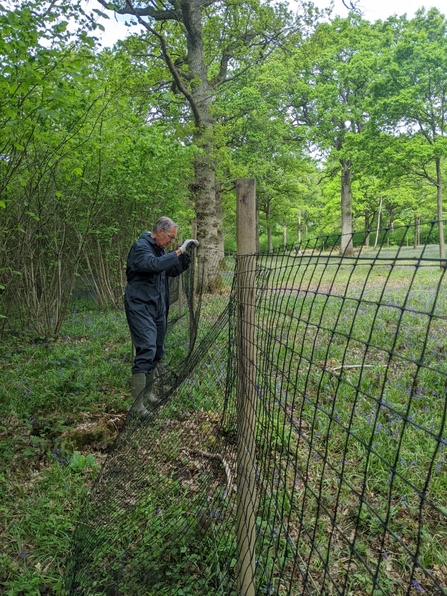
Patrick working on a fence by Charlie Harland
During the first hectic month or so, I have acquired many new skills under the guidance of team leader Andy; replacing gateposts, installing deer fencing, tree inspections, installing dormouse nest-boxes, driving a Land Rover and many more. I have been out with Trust ecologist, Joshua, conducting newt and bat surveys. I have assisted reserves officers with boundary issues, supervising contractors (re-assembling a windpump at Gwen Finch) and public engagement with the wardens. I have been out with a licenced dormouse team checking and recording nest-boxes and I already have my brush-cutter certificate!
I have also had two opportunities to go out with the roving volunteer group, assisting reserves officer Dom with the first ever volunteer tasks on the Trust’s newest nature reserve at Green Farm. The reserve consists of eight meadows, with a total area of 23.9 hectares, adjacent to the well-established Monkwood reserve, well known for its fantastic range of butterfly species including the scarce wood white, which is now spreading around the county.
On the first occasion, fellow new-recruit Charlie and I began the day at Lower Smite Farm, sorting out the tools required for a day of thistle pulling and, as we had fewer volunteers than normal, loading them into the Isuzu rather than the minibus. We were met at Monkwood by more volunteers than we expected, given the forecast for thunderstorms, but fortunately Charlie and I had allowed for this. It was still dry but overcast so we walked through a very muddy Monkwood to the entrance to Green Farm, unfortunately, without the usual butterflies.
At the north end of Green Farm (Bullock’s Ground), we stopped whilst Dom explained some of the innovative management ideas that are planned to increase the biodiversity of the site and connectivity between our land and nearby sites of Ockeridge Wood and Monkwood Green; creation of wood pasture, an orchard, new woodland and hedges. In Bullock’s Ground itself, a hedge that was grubbed out many years ago will be re-instated (in autumn by the roving volunteers) and both parts of the meadow will then be planted with a very low density of trees. These will be allowed to form wide canopies, eventually creating traditional wood pasture, a habitat that hasn’t been seen in Worcestershire for probably 300 years. The two halves will be managed differently; one field will be cut and grazed as a hay meadow but the other will be left largely unmanaged.
Small yellow underwing by Patrick Taylor
We continued to the largest meadow on the site (Long Meadow), which has the highest diversity of plants and will continue to be managed as a hay meadow. The meadows at the south of the site are less rich floristically and one, known as June’s Wood, is to be returned to an open style of woodland. Finally, we arrived in the area known as Little Plains and this is the area where creeping thistle is becoming abundant and will, in time, dominate the meadow if left unchecked. The volunteer task was simply to pull out as many thistles as possible. This may not be the most popular of volunteer tasks but experience has shown that these tasks are quite effective and that considerably fewer thistles appear the following year. The aim is to reduce rather than eradicate. We all set to this task and worked steadily until lunch, enjoying the passing butterflies and bumblebees. We also found a couple of interesting moths that were photographed for subsequent identification (scorched carpet and small yellow underwing – thanks to volunteers Jane and Dave for help with the identifications). Roving work parties are not just about physical work.
We broke for lunch and as we were eating, we realised that black clouds were gathering and we could hear rumbles of thunder from both the north and south. Dom decided that we would immediately take the short cut back to the car park and we only just made it before the storm broke. We sometimes work through rain but definitely not thunderstorms!
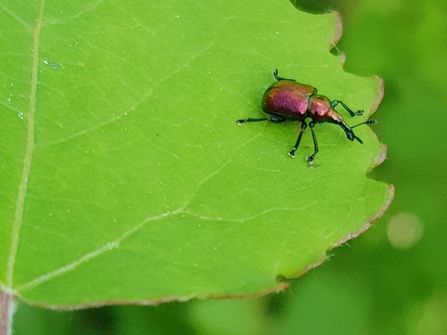
Aspen leaf-rolling weevil by Patrick Taylor
Two weeks later, I found myself out with the roving volunteers again, this time with trainee Carolyn, and due to a last-minute change of plan, we were visiting Green Farm to continue with the thistle pulling. This time, the weather was warm and sunny and we were able to spend a bit longer on the task, which was also easier because the thistles had grown and were easier to pull out and less inclined to break off at the surface. The better weather also enabled Dom to show us more of the special wildlife of the reserve including one of Monkwood’s rarities, the aspen leaf-rolling weevil Byctiscus populi. Adults overwinter and emerge in early spring to search for leaves of young aspen trees. After mating, the female (sometimes assisted by other individuals) rolls an aspen leaf into a thin cigar-shaped tube and deposits several eggs into this structure. The leaf then dies and falls off the plant to the ground. Once hatched, the larvae feed on the decaying leaf tissue and then probably pupate in the ground to emerge as adults some weeks later. Thanks to volunteer Jess for the photos, which were much better than mine! We also found a good number of wood whites.
There will be more roving tasks at Green Farm in future weeks and months, including the hedge planting in the autumn, and volunteers will have an opportunity to make a real contribution to increasing the diversity of the site. Eventually, the site will be incorporated into the Monkwood nature trail and make the visitor experience even more rewarding. You can read about the progress of the project on the Monkwood musings blog.
I’m not sure where my traineeship will eventually lead me but so far it has already been an amazing opportunity to learn new practical skills and to gain an insight into the aspects of the work of the reserves officers and others that no one ever sees. I'm looking forward to learning even more in the coming months.
A long-standing naturalist, Patrick Taylor has taken the plunge and is loving the change of career from engineering to nature conservation.
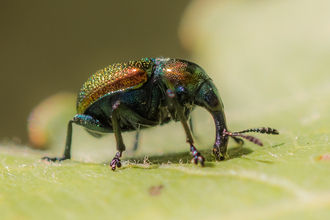
The bioblitz blog
Julie takes a look at how recording the wildlife we spot is important and how you can get involved...
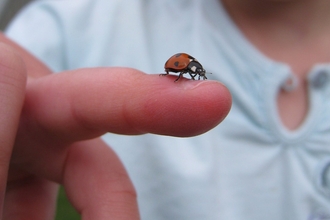
Making a difference...together
Julie takes a look at eco-anxiety and how to overcome it...together...
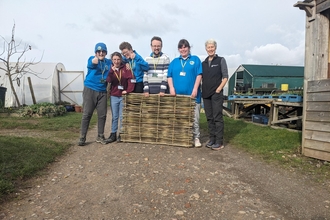
Communities learning new skills with local conservation charity
With the help of Worcestershire Wildlife Trust, community groups have been learning new skills and supporting wildlife.

